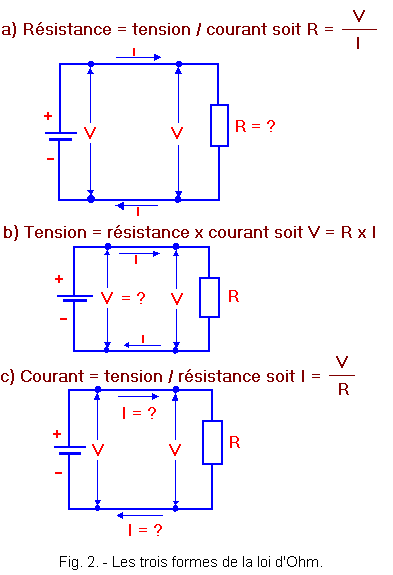
Created it, 05/10/15
Update it, 05/11/24
N° Visitors
![]()
THE LAW OF OHM “2nd PART”
We thus observe that of the three electric quantities considered in our circuit the only one which did not vary is resistance since we always preserved the same component. We can think that this constant size is equal to the result, itself constant, of the division of the tension by the intensity of the current.
OHM noted this reality and stated its law in the following way :
But to vary the current which circulates in the circuit, we can vary resistance instead of the tension: indeed, as resistance is an obstacle with the flow of the current, if it is increased one must decrease the current, because it meets a larger obstacle.
We can easily check this fact, while preserving or by taking a pile, and by replacing resistance by other components which have an increasingly large resistance: one measures the intensity of the current in each case, and one can note that if resistance increases, the current decreases.
So then we multiply the resistive value of each resistance by the current which crosses it, we always find the same value although resistance and current vary.
In this case, of the three electric quantities, only the tension remains constant bus the same pile is used. We can thus think that the value found by multiplying resistance by the intensity of the current which it cross-piece is the value of the tension of the pile.
There too, OHM noted this established fact and could state its law in this second way:
This point, we can observe that to vary the current, we initially varied tension and resistance separately. Let us see now what occurs if the tension and resistance vary simultaneously and in the same proportions.
In this manner, if one divides the tension by resistance, one always finds the same value. In addition, if one measures the current which circulates in the circuit for each case, we realize that it always preserves the same value: we can thus think that the value found by dividing the tension by resistance is precisely that of the intensity of the current.
In this case still, OHM arrives at this conclusion, which made him state its law in a third way
One obtains the intensity of the current by dividing the tension by resistance.You should not think that there are three laws of Ohm: the law of Ohm is single, but as it binds between them three electric quantities (tension, intensity of the current and resistance) it can be presented in three different forms, according to the size which one makes depend on the others.
The law of Ohm thus makes it possible to calculate one of the three sizes by knowing the two others. For good to give an account of this to you, look at figure 2 on which the three cases are represented in which the law of Ohm can be used in its three different forms. (the law of Ohm will be shown in detail in the page entitled “Mathematical”).

It can happen that one wants to calculate the resistance of a circuit to which a pile is connected, which gives a certain tension, for example 15 volts, and which makes circulate a current of 3 amps (figure 2-a). In this case, one calculates resistance by dividing the tension by the intensity of the current, it is enough to apply the formula of the law of Ohm :

One can, on the contrary, want to calculate the tension which a pile must have to make circulate a current determined in a circuit of known resistance (figure 2-b) : in this case, one calculates the tension by multiplying resistance by the intensity of the current. Let us take the same values that above, we will have :

One can finally want to calculate the current which circulates in a circuit of known resistance to which a pile is connected which gives a known tension (figure 2-c) : in this case, one calculates the intensity of the current by dividing the tension by resistance. Always let us take the same evoked values.

Note : The symbol of the tension, can be is V or U. Of these three examples, we can include/understand the great utility of the law of Ohm for practical calculations: always keep in memory figure 2 and the three forms of the law of Ohm. As you can note it, one falls our feet of course, since we have the three results well to know : 5 Ohms, 15 Volts and 3 Amps.
We go as of now noting the utility of this law by applying it to the analysis of the connections series and parallel.
![]()
| Following
page |